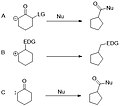Ring expansion and contraction
Ring expansion and ring contraction are chemical reactions that alter the size of a cyclic molecule by increasing or decreasing the number of atoms in the ring. These reactions are significant in organic chemistry, particularly in the synthesis of cyclic compounds, which are common in both natural products and synthetic pharmaceuticals. Understanding these processes is crucial for designing synthetic routes to complex molecules.
Mechanisms of Ring Expansion
Ring expansion typically occurs through a series of steps involving the generation of a more stable carbocation intermediate. The most common mechanisms include:
- Wagner-Meerwein rearrangement: This involves the migration of an alkyl or aryl group from one carbon to a neighboring carbon, resulting in the expansion of the ring. The driving force is the formation of a more stable carbocation intermediate.
- Pinacol rearrangement: In this reaction, a 1,2-diol is converted into a ketone, facilitating the expansion of the ring. This rearrangement involves the migration of a group adjacent to a carbocation generated by the loss of a leaving group.
- Beckmann rearrangement: Although primarily known for converting ketoximes to amides, this rearrangement can also lead to ring expansion when applied to cyclic ketoximes.
Mechanisms of Ring Contraction
Ring contraction reactions are less common than ring expansions but are equally important. They typically involve:
- Favorskii rearrangement: This reaction involves the contraction of a ring through the action of a base on a haloketone, forming a smaller ring and an alkene.
- Schmidt reaction: This reaction involves the reaction of hydrazoic acid with ketones or aldehydes to form smaller rings and nitrogen gas.
- Ring contraction via carbocation rearrangement: Similar to ring expansion, ring contraction can also occur through carbocation intermediates, where the ring contracts to form a more stable carbocation.
Applications in Synthesis
Ring expansion and contraction reactions are powerful tools in the synthesis of complex organic molecules. They allow chemists to:
- Access cyclic compounds of different sizes, which are crucial in the synthesis of natural products and pharmaceuticals.
- Modify the ring size to influence the biological activity and physical properties of a compound.
- Generate structural diversity in synthetic libraries for drug discovery.
Challenges and Considerations
While ring expansion and contraction provide versatile methods for modifying cyclic structures, they also present challenges:
- Regioselectivity and stereoselectivity can be difficult to control in these reactions.
- The formation of undesired by-products or isomers may complicate purification.
- The stability of intermediates and the potential for rearrangement reactions must be carefully considered.
Conclusion
Ring expansion and contraction are essential reactions in organic chemistry, offering pathways to synthesize cyclic compounds of varying sizes. These reactions are instrumental in the development of new drugs and materials, highlighting the importance of understanding their mechanisms and applications.
Transform your life with W8MD's budget GLP-1 injections from $125.
W8MD offers a medical weight loss program to lose weight in Philadelphia. Our physician-supervised medical weight loss provides:
- Most insurances accepted or discounted self-pay rates. We will obtain insurance prior authorizations if needed.
- Generic GLP1 weight loss injections from $125 for the starting dose.
- Also offer prescription weight loss medications including Phentermine, Qsymia, Diethylpropion, Contrave etc.
NYC weight loss doctor appointments
Start your NYC weight loss journey today at our NYC medical weight loss and Philadelphia medical weight loss clinics.
- Call 718-946-5500 to lose weight in NYC or for medical weight loss in Philadelphia 215-676-2334.
- Tags:NYC medical weight loss, Philadelphia lose weight Zepbound NYC, Budget GLP1 weight loss injections, Wegovy Philadelphia, Wegovy NYC, Philadelphia medical weight loss, Brookly weight loss and Wegovy NYC
|
WikiMD's Wellness Encyclopedia |
| Let Food Be Thy Medicine Medicine Thy Food - Hippocrates |
Medical Disclaimer: WikiMD is not a substitute for professional medical advice. The information on WikiMD is provided as an information resource only, may be incorrect, outdated or misleading, and is not to be used or relied on for any diagnostic or treatment purposes. Please consult your health care provider before making any healthcare decisions or for guidance about a specific medical condition. WikiMD expressly disclaims responsibility, and shall have no liability, for any damages, loss, injury, or liability whatsoever suffered as a result of your reliance on the information contained in this site. By visiting this site you agree to the foregoing terms and conditions, which may from time to time be changed or supplemented by WikiMD. If you do not agree to the foregoing terms and conditions, you should not enter or use this site. See full disclaimer.
Credits:Most images are courtesy of Wikimedia commons, and templates, categories Wikipedia, licensed under CC BY SA or similar.
Contributors: Prab R. Tumpati, MD

